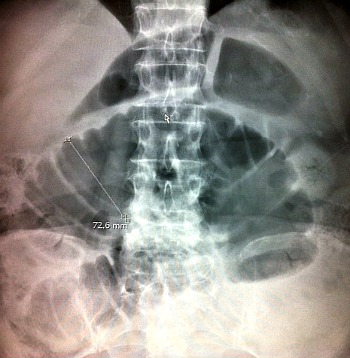Symptoms of Abdominal Adhesions
The following are symptoms of abdominal adhesions you should
be alert to, if you have had any form of surgery or operation in your
abdomen.
They include intermittent abdominal pain or cramping, nausea, bloating,
abdominal distension and in severe cases, constipation and bowel
obstruction.
Current medical evidence shows that you have a 9 chance out of 10 to develop abdominal adhesions if you have had one or more surgical operations in you abdomen.
As we explained on the abdominal adhesion page, an adhesion is a sticky thread-like strand that develops after healing takes place inside the body following an injury or surgical operation or infection or even after an internal bleeding.
Normally, the surfaces of the organs including the outer wall of our intestines are covered with slippery jelly-like liquid that makes movement and contacts between the organs and bowel loops supple, sleek and unobstructed.
Following an operation or injury or infection, scar tissues are formed inside the body – exactly like scars are formed on the skin after a wound. These scar tissues tend to be drawn out like threads or spider webs.
They can then wrap around loops of bowel or make surfaces of organs stick together. If this happens inside the abdomen, they are called abdominal adhesions.
Adhesions can happen outside the abdomen too. You can have adhesions form inside:
- The womb – causing blockade of the lumen of the fallopian tube leading to infertility.
- Joints like the shoulder joints, hip joints,
- Eyes or indeed inside the
- Heart
- Bladder
- Pelvis
Risks Factors And Causes of Adhesions
You are more likely to suffer with abdominal adhesions or scar tissue formation if you have had any of the following conditions or a combination of them. They include:
- Operation for appendicitis (especially if it was a very bad appendicitis with pus or if it ruptured)
- Gallbladder surgery
- Caesarean Section operation for the delivery of your baby
- After hysterectomy (operation to remove the womb)
- Endometriosis or an operation for endometriosis
- Any other major operation to take a look at something in your abdomen or repair a problem
- Pelvic Inflammatory Disease (PID) or salpingitis
- Ulcerative colitis
- Crohn’s disease
- Diverticulitis
- Peritonitis or infection of the inside of the abdomen in the past
- Cancer inside the abdomen – in the stomach or bowels or kidneys, or pancreas, or bladder
- Radiotherapy involving the abdomen
- Tuberculosis of the abdomen
- Other causes of intestinal or abdominal adhesions include the use of starch, talc, gauze or silk inside the abdomen during surgery.
Though most cases of adhesions occur only following surgery, injury of certain diseases as listed above, a few persons are born with what doctors refer to as congenital adhesions or scar tissues. They too can develop symptoms of abdominal adhesions without having had previous operation.
Symptoms of Abdominal Adhesions
So, what exactly are the symptoms of abdominal adhesions?
If you have had any surgical operation that involved going inside your abdomen or pelvis in the past and experience any of the following, it is more than 80% possible that you are suffering with the symptoms of abdominal adhesions. The symptoms include:
- Central or lower abdominal cramps or discomfort on and off
- Feelings of bloating
- Nausea
- Abdominal pain with bloating and difficulty opening your bowels
- Constipation
These symptoms tend to go on for a long time. The typical story is that you will be examined at the initial stages and nothing would be found.
In severe cases, abdominal adhesions lead to bowel or intestinal obstructions. In fact, it is reported in medical journals that 80% of people who develop obstruction of their small intestines, do so due to abdominal adhesions.
Can Abdominal Adhesions Get Worse?
A study published in the Annals of the Royal College of Surgeons of England reported that in 2708 patients who had abdominal operations, 14 of them developed symptoms of abdominal adhesions within one month. After a year, that number rose to 26.
Over a 10 year period, it is predicted that at least over 90% of patients who had abdominal or pelvic operation would develop adhesions.
This trend thus shows that abdominal adhesions can get worse over time.
It must be said though, that even though over 90% of those who have undergone an abdominal or pelvic surgical operation would develop adhesions, it is not everyone who develops adhesions that would necessarily develop symptoms.
A worsening symptom of moderate to severe abdominal pain, abdominal distension or bloating, nausea and vomiting and then constipation in anyone who have had previous surgery on the abdomen should alert him or her to the development of bowel or intestinal obstruction which is the main complication of abdominal adhesions.
Is that what you are feeling? You should contact your doctor now.

Abdominal Adhesions - Share Your Experience
Do you have a story about abdominal adhesions? Any question or comment? Share it!
Please feel free to contribute your thoughts here if you read postings by others, and you want to say something.
All postings are read by the abdominal pain team, and we shall respond to some queries directly on this page too.
|
Help Keep This Site Going |
Return To Adhesions Overview Page From Symptoms of Abdominal Adhesions Page



